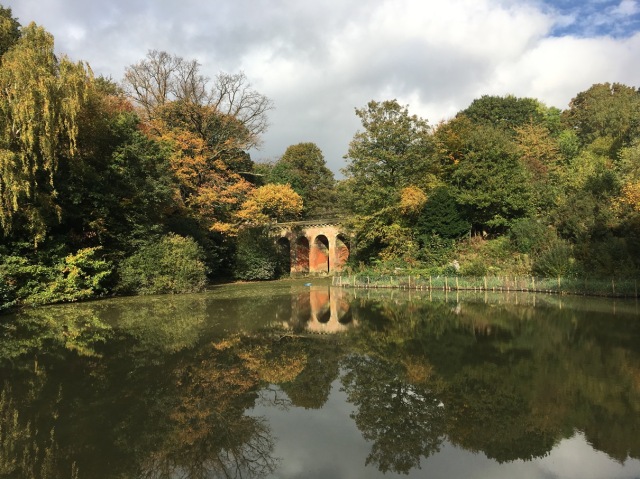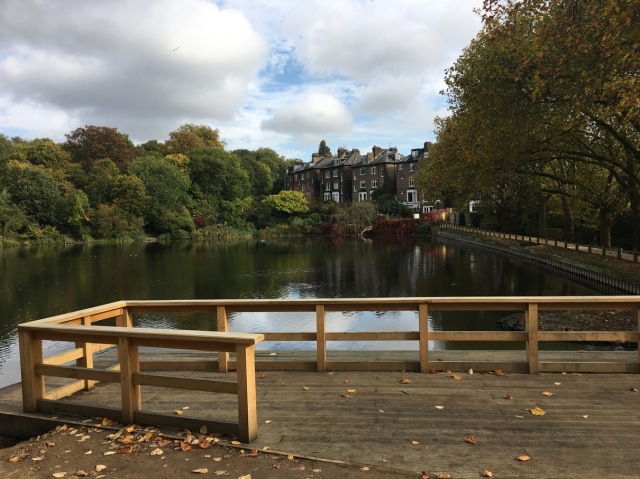Now that the construction element of the project has finished, I thought a post describing what has happened at each pond, along with an explanation of how these works improve dam safety, might be useful. In this post I will concentrate on the Highgate Chain and I will then go on to describe the Hampstead Chain in a future post.
There are five ponds in the Highgate Chain which come under the management of the City of London. A further two ponds are in the Kenwood estate and are managed by English Heritage. The Highgate Chain has a big catchment, which means water from a large area ends up in the pond chain – this is due to the geography of the Heath and the fact that water flows off the hills around the ponds.
Stock Pond

Stock Pond
Stock Pond is a relatively small pond and receives water from the two ponds in the Kenwood Estate, as well as run off from the surrounding hills. There had been flooding issues at this pond in the past, and during a flood in 2010 the dam was damaged when the pond water came over the top of the dam (overtopping) and caused some erosion to the downstream side of the earth dam.
The work carried out here as part of the Ponds Project includes raising the dam by half a metre. A spillway was also constructed. A spillway is a construction which allows water to leave a pond safely and in a controlled way so that it does not flow over the top of the dam and cause damage. At the Stock Pond the spillway is a large grassy area, and was designed so it would fit in with the surrounding landscape. The spillway is lower than the new raised dam so if water levels do rise then water leaves the pond via the spillway and flows over ground down to the next pond, in this case, Ladies Pond. The final piece of work at this pond was to add a culvert, or a large pipe, which allows water to flow out of the pond and then down a stream into the Ladies Pond. This replaces an existing pipe which often used to get blocked with silt. Water will flow down this pipe continuously, except in dry periods when the flow stops.
Several trees were removed from the edge of this pond, including some oaks, to allow for the spillway to be constructed. We have planted some additional aquatic plants in the pond which will help with water quality and will also provide a good habitat for birds, fish and invertebrates. Aerators have also been added to all of the ponds, which add oxygen to water to improve water quality. Finally, silt was also removed from the bottom of the pond which will also help improve water quality.

Stock Pond
Kenwood Ladies Bathing Pond
Part of the works at this pond have included replacing the building which sits on the dam. This had to happen for two reasons. Firstly the building was on the dam, which needed to be raised slightly, and secondly when we got the results back from survey of the concrete deck it was found to be in very poor condition. The old changing rooms have been replaced with two buildings. One provides changing facilities and toilets, and the other is the lifeguards facility. The building was prefabricated in a warehouse and brought to the Heath in five sections. You can see photos of this process in this post. This method of construction was chosen to shorten the construction period so that the pond was closed for the shortest time possible.
The other works included building a spillway, so like Stock Pond, water could leave the pond safely and flow down to the next pond (Bird Sanctuary).

Ladies Pond building, with incomplete spillway in foreground
The spillway at Ladies Pond is also grass lined and at the bottom it has a concrete stilling basin. The pipe which allows a flow of water from Ladies Pond to Bird Sanctuary was also replaced and enlarged. Some additional aquatic plants and an aerator were also added. Silt has been removed from the pond. All of these factors will contribute to better water quality and we’ve already had reports from swimmers that the situation is much improved. At the top end of the pond some wetland scrapes were also added to naturally filtrate the water, and remove silt as it flows down from Stock Pond.
Several trees were removed from the spillway area and we will be planting some replacement trees in this location, but we have also received positive feedback from swimmers on the additional light in the pond as well as a more open view thanks to the tree removal.
Bird Sanctuary
Bird Sanctuary pond is a haven for wildlife thanks to being completely fenced off from the public. It is a home to many types of bird, including the kingfisher. It is because of this special status that works on this pond were kept to an absolute minimum, with the vast majority being focussed on environmental improvements, described here. Some very slight leveling of the dam took place, which in reality just looks like path resurfacing works. One of the pipes which connects Bird Sanctuary to Model Boating Pond was also enlarged.

Bird Sanctuary
Model Boating Pond
The vast majority of the works across the entire Ponds Project happened around the Model Boating Pond. The works were focussed here for a number of reasons:
- Its location in the middle of the Highgate Chain makes it a good place to store extra water – it can store the water coming from the ponds above it, and is far enough away from the end of the chain where the risk of overtopping and dam failure has the biggest consequence to the communities south of the Heath.
- It was the most municipal-looking pond on the Heath – with hard sheet metal piling around all sides. The new design softens the hard edges around the north, south and west of the pond, re-profiles the pond to a more natural shape and introduces more aquatic planting which benefit wildlife and water quality.
- It is located between two hills, which means by building up a clay dam at the southern end of the pond – in front of the existing dam – there is a natural bowl created which can hold water in the case of an extreme flooding event. In this event the Model Boating Pond and the Bird Sanctuary Pond would join as one pond temporarily. The water stored would then be released in a more controlled manner after the peak of the flood has passed.
A new dam was created using clay found in the borrow pits (located to the west of the pond within the large work compound) and from the western edge of the pond which has been excavated and re-profiled leaving an island (linked by a causeway) – which saves a group of mature trees.
A spillway has been created in the south-west corner of the pond. This is made of reinforced grass turf and in the event of a large flood, will allow water to safely leave the pond, and travel down to Men’s Bathing Pond, without over-topping and potentially causing damage to the dam. Aerators have also been added to replace much larger pieces of equipment which were there previously.

Model Boating Pond
Men’s Bathing Pond
At Men’s Pond the dam has also been raised but this time by a sheet metal wall with an oak capping. The wall runs the length of the dam except for the spillway in the south-west corner. Aquatic plants have been put in front of it to camouflage it from the pond-side, and also improve water quality.

The spillway is grass lined and allows water to safely leave the pond in the event of a large flood.

Men’s Pond spillway
Other environmental improvements include a small check dam in the north-west corner to filter water before it enters the pond, and the addition of two aerators. Silt was also removed from the pond last winter. Men’s Pond had issues with blue-green algae in the past and we hope these environmental enhancements will help with this.
Highgate No. 1 Pond

Highgate No. 1 Pond
The final pond in the Highgate Chain is Highgate No. 1, It is also the pond closest to a high density of residential properties. The dam has been raised by 1.25m with a sheet pile wall with an oak cap, similar to the work that took place at Men’s Pond. A grass lined spillway has also been created at the southern edge of the pond. This allows water to leave the pond safely in the event of a large flood. A timber retaining wall made of timber sleepers has been built along the eastern edge of the spillway (where the boundary of the Heath meet’s Brookfield Mansion’s boundary). A similar wall has been built at the other end of the dam, on the land of one of the adjoining landowners.

Highgate No. 1 spillway
Pipes which connect the Highgate No. 1 Pond to the sewers have been retained and in a normal flow water leaves the pond this way. If the Highgate No. 1 spillway ever does come into use, during a very large storm, the water flows down the spillway and down the hill, where it eventually finds its way into the sewers through gutters and land drains. Flood water is not retained permanently on the Heath but because of the extra storage incorporated at Model Boating Pond, it is temporarily stored and then released gradually after the peak of the storm. An aerator and aquatic plants were also added here to help improve water quality.
The works on this chain have eliminated the chance of uncontrolled overtopping of the dams and increased the standard of protection against flooding downstream.
If you are interested in more technical information on the design development and the basic principles of the scheme, the Preferred Solution Report might be of interest to you.
A concise history of the project can be found here.





















































